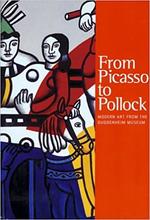More about Constantin Brâncuși
- All
- Info
- Shop
Works by Constantin Brâncuși

Sr. Editor
Constantin Brancusi was an odd duck.
Born in rural Romania to an extremely poor farming family, Brancusi never quite fit in. He was a sensitive artist type who took a lot of flak from his dad and step-brothers. So much so that he ran away from home at the age of eleven. This was, as you might expect, problematic because eleven year olds aren’t very smart and have no skills. Brancusi took lots of odd-jobs, but the one he would use to answer the “weirdest job” question in a People magazine interview is definitely: fortune teller.
Posing as a fortune teller may have been the start of a lifelong affectation. Brancusi always played up his poor Romanian roots, and this was a time when people thought Romania was full of werewolves and vampires. He listened to folk music, dressed in traditional robes and made his chic Paris studio look like a peasant’s house. This created a mythology around Brancusi as an artist with primitive instincts, even magic. And we think the enterprising young runaway used this to his advantage. It definitely makes me question the validity of his epic tale about walking to Paris from Romania. But I’m from LA, so even walking to the corner store sounds outlandish to me.
When he got to Paris, boy were his feet tired! No, actually he worked with sculptor Auguste Rodin. Brancusi left the uber-talented Rodin to do his own thing because, as he poetically said, “Nothing can grow under big trees.”
Out on his own, Brancusi further cultivated his self-image as a strange foreign artist and the Paris elite ate it up. While he never liked to give an interview, he did like to entertain at his house with food and lots of booze. Especially if ladies were there to help him drink the booze. One journalist barf-ingly called him a “legendary lover.” Must have been, because he even bagged Peggy Guggenheim, who later collected and exhibited his work. She said that every time she’d visit his studio, he’d show her his sculptures one by one as if it were the first time. Yikes. Dude must have been a good lay if she dealt with that!
Featured Content
Here is what Wikipedia says about Constantin Brâncuși
Constantin Brâncuși (
Romanian: [konstanˈtin brɨŋˈkuʃʲ] ⓘ; February 19, 1876 – March 16, 1957) was a Romanian sculptor, painter, and photographer who made his career in France. Considered one of the most influential sculptors of the 20th century and a pioneer of modernism, Brâncuși is called the patriarch of modern sculpture. As a child, he displayed an aptitude for carving wooden farm tools. Formal studies took him first to Bucharest, then to Munich, then to the École des Beaux-Arts in Paris from 1905 to 1907. His art emphasizes clean geometrical lines that balance forms inherent in his materials with the symbolic allusions of representational art. Brâncuși sought inspiration in non-European cultures as a source of primitive exoticism, as did Paul Gauguin, Pablo Picasso, André Derain, and others. However, other influences emerge from Romanian folk art traceable through Byzantine and Dionysian traditions.
Check out the full Wikipedia article about Constantin Brâncuși


















